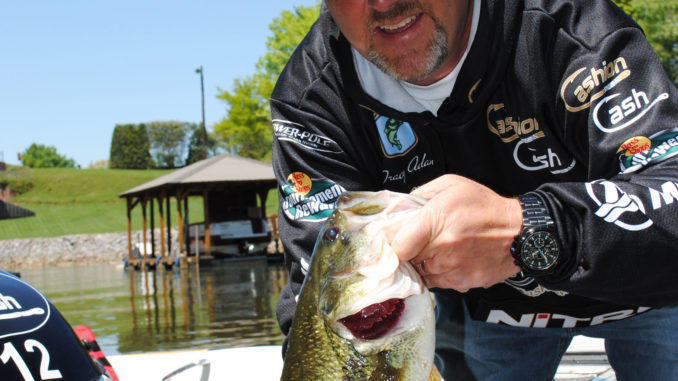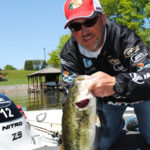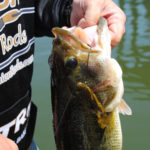
Treat this Catawba River reservoir like a big creek and target bass in the cuts and pockets.
Bass pro Tracy Adams has made no bones about the fact that he’s most comfortable fishing for bass in shallow water. He loves picking up his baitcasting rod and flipping or pitching soft-plastic crawfish baits into a couple of feet of water, setting the hook when a nice largemouth grabs hold.
That might be a big reason why Adams spends as much time as he can in April on Lake Hickory. There are lakes closer to his Wilkesboro home, but none where he feels like he has the chance to have as many nice bass pick up his baits as the 4,225-acre reservoir north of its namesake city.
“This lake is good and has been for a long time,” said Adams, 40, who grew up fishing on the lake with his father, David. “Right up until the time it gets tough in August, it takes about 18 pounds (five fish) to win tournaments. There are a lot of 3- to 3 ½-pound fish in this lake.”
And Adams said there’s no better time to catch a big bag of bass than April, when fish really head to the bank with lovin’ on their minds. Being a relatively clear reservoir, Adams looks forward the period of several weeks when he can drop his trolling motor and scan the 105 miles of shoreline for bass moving up to spawn. Not all of the fish he catches are actually in the process of reproducing, but all of them are thinking about it.
“When the big spawn takes place depends on where the moon hits,” Adams said. “There will be big waves of fish go in on the full (April 15) and new moons (April 29). The fourth or fifth of the month is about the earliest you’ll find ‘em if you have good weather; I think the fishing really gets good about the 10th or 12th.
“The majority of the big ones will go up first. I’m not saying you can’t catch a big bass later on, but the first wave is usually gonna have most of the big ones. And the spawn will work from the lower end to the upper end. There’s about a 2-week difference between the two ends of the lake. At the end of the spawn on the lower end, you’ll still have some fish bedding, while the bigger ones will be going on up the lake. You run the lake and look for the waves of big fish moving in.”
Lake Hickory is approximately 11 miles long between Oxford Dam on its lower end, just west of the US 16 bridge across the Catawba River, and Rhodhiss Dam upstream, a mile or so west of the US 321 bridge. Because the water will warm up earlier on the lower end, fish there will get active a little earlier and spawn a little earlier. The difference in water temperature between the lower and upper ends can be as much as three or four degrees, and that’s the kind of thing Adams keep his eye on.
Like several reservoirs on the upper section of the Catawba River, Lake Hickory fishes much like a river. It’s a relatively narrow lake; in places, barely a half-mile separates the southern shoreline in Catawba County and the northern shoreline in Alexander or Caldwell counties.
“It’s so much like a river, that you’ve almost got to think about this whole lake as one big creek, and you’re fishing the pockets off that big creek,” said Adams, who has qualified for two Bassmasters Classics — finishing sixth in 2013 – and six FLW Tour Championships and won almost $700,000 in prize money. “It’s so narrow that it’s not far for fish to go from the river channel to the places they spawn.”
Lake Hickory has three main tributary creeks — Gunpowder Creek and the Upper and Middle Little rivers — all of which drain the foothills along the northern side of the lake, but when fish get ready to move shallow, it’s the pockets and cuts off the main river where Adams does most of his looking. It’s easier to target areas where bass are staging on their way to the backs of those pockets where they bed, and the little pockets and coves stay clearer.
“A lot of times, they’ll go all the way to the back of those little places before they move up,” Adams said. “You can catch ‘em on jerkbaits in the center of those little coves in 10 to 12 feet of water, or you can catch ‘em on crankbaits on the little corners. The first fish that go up, you’ll find them in the backs, and as the spawn progresses, you’ll start finding ‘em out toward the mouth of the little cuts. You just try and dodge the wind and fish whichever side the clearer water is.”
Adams works every piece of visible cover he sees while he’s on his way back into a creek. He said that fish will hold on pier pilings, stumps and laydowns out to about five or six feet of water, either staging there or actually spawning. Plenty of the bass he catches, he never sees before he sets the hook because they’re working their way back into the pockets or cuts.
“Most of the time, they’ll be out off the bank a little bit, unless the lake’s really good and full, and then they’ll bed right on the bank. But most of the time, they’ll be out a ways, maybe two feet deep; it makes ‘em a little harder to see,” he said.
“A good way to find ‘em is to fish along a bank, prospecting. I find more fish taking my time, working along, pushing along, than I do going down the bank 100 miles an hour just looking. That’s why it’s good to go along and cast into depths where you can’t see, at anything that might be around – a pole or a stump. It seems like the little cuts have been better to me than the bigger coves.”
Although he might fish a jerkbait or a small crankbait, most of the time, Adams is pitching or flipping with a 7-foot, heavy-action Cashion baitcasting rod, a Johnny Morris signature series reel spooled with 17-pound XPS fluorocarbon, a 5/16th-ounce worm weight and a Zoom Speed Craw rigged Texas-style on a 4/0 Owner hook. He likes watermelon and green pumpkin as his primary colors, but he’ll switch to white if fish he can see appear to be too finicky.
“Sometimes you’ve got to change up,” Adams said. “Most of the time, it doesn’t matter, but sometimes it will. If you’ve got one just nipping at it, I’ll change from watermelon or green pumpkin to white, and white will usually work.”
DESTINATION INFORMATION
HOW TO GET THERE/WHEN TO GO — Lake Hickory is a few miles north of the city of Hickory. Part of Duke Energy’s Catawba River system, its headwaters are the tailrace below Rhodhiss Dam, a few miles west of US 321. NC 127 crosses at mid-lake, and US 16 crosses the river just a few hundred yards downstream from Oxford Dam, which impounds the lake. Good access is from I-40, which parallels the lake. The Oxford Access is a mile off US 16 on the south side of the lake; the Whittenburg Access is on the north side of the lake at the NC 127 bridge. April is the top month to catch bass on Hickory; the heaviest waves of spawning fish will move into the shallows on the full moon (April 15) and the new moon (April 29).
TECHNIQUES — Do most of your fishing in the pockets and cuts off the main lake, starting on the lower end and moving with the spawn as it works its way up the lake. Work your way back in coves and pockets, fishing the outside corners with small crankbaits and the deeper water in the center of the cove with a jerkbait or Alabama rig. Pitch or flip to visible cover with a soft-plastic crawfish for staging fish, and target spawning fish with the same lures. Areas with warmer water and sun-drenched banks will hold more spawning fish.
FISHING INFO/GUIDES — Lyndon’s Riverview Sport Shop, US 16, 828-632-7889; Lakeside Marina, NC 127, 828-495-8181. See also Guides and Charters in Classifieds.
ACCOMMODATIONS — Hickory Metro Convention & Visitors Bureau, 800-509-2444, www.hickorymetro.com; Catawba County Chamber of Commerce, 838-328-6111, www.catawbachamber.com.
MAPS — Kingfisher Maps, 800-326-02457, www.kfmaps.com; Duke Energy, www.duke-energy.com/pdfs/hickory.pdf.






Be the first to comment